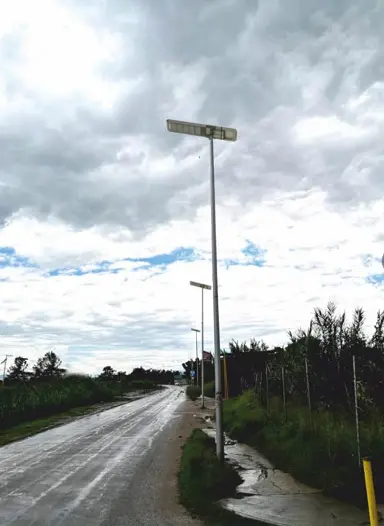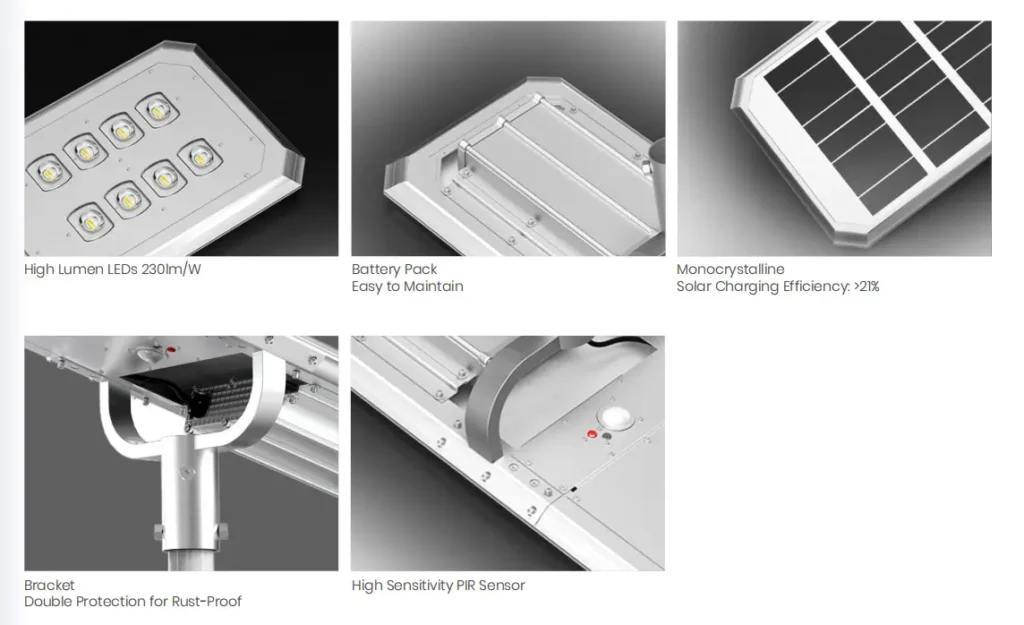In today’s world, with the growing awareness of environmental protection and the widespread adoption of sustainable development concepts, solar technology is gradually emerging in the lighting field due to its clean and renewable characteristics. Particularly in special environments, the installation of solar street lights is not only a technological challenge but also a quest for innovative solutions. This article will discuss the successful installation of the Atlas series solar street lights by Sresky Company in Mexican suburban trails, delving into the practices and profound insights gained from installing solar street lights in special environments.

I. Challenges and Opportunities of Special Environments
Mexican suburban trails, as a quintessential example of a special environment, are characterized by unstable sunlight hours, climate variability, and complex terrain. These features pose numerous challenges for the installation of solar street lights. However, these challenges also foster significant opportunities.
In the Mexican suburban trails, the instability of sunlight hours necessitates higher solar panel conversion efficiency and superior energy storage systems for solar street lights. Climate variability demands that street lights have excellent corrosion resistance, as well as the ability to withstand high and low temperatures and wind. The complexity of the terrain requires a higher level of installation expertise and stability.
Confronted with these challenges, Sresky, with its extensive experience and advanced technology, chose the Atlas series of solar street lights as the solution. This series, known for its high efficiency, intelligent control, and environmental adaptability, has been successful in over 3500+ global solar street light bids. It has become the ideal choice for solar street light installations in special environments.
Installation Example of the Mexican Suburban Trail
In the Mexican suburban trail solar street light installation project, Sresky Company thoroughly considered the environmental specifics and selected the Atlas series solar street light. This series, with its high efficiency, intelligent control, and environmental adaptability, successfully addressed a variety of environmental challenges.
Firstly, they opted for high-efficiency monocrystalline silicon solar panels, which have a higher conversion rate and can maximize the use of limited sunlight resources. Additionally, the integration of a high-capacity lithium battery storage system ensures that the streetlights operate stably even during continuous rainy weather.
Secondly, during the installation process, engineers faced undulating terrain and variable soil conditions. To counter this, they conducted precise geological surveys and employed innovative foundation treatment methods tailored to the actual conditions. These methods ensured that the streetlights were securely installed and remained stable under adverse weather conditions. Furthermore, considering the living habits and lighting needs of local residents, the layout and lighting angles of the streetlights were carefully designed to provide even coverage and sufficient illumination.
Moreover, the high color temperature and rendering (fixed color temperature 5700K, color rendering index Ra>70) of the Atlas series solar street lights ensure lighting quality and visual comfort. The extended lighting function during rainy days ensures continuous operation for over 10 days under continuous rain.
Third, Innovative Design and Installation of Solar Street Lights
In the case of the Mexican suburban trails, several innovative aspects of solar street light design and installation were observed. Beyond the Atlas series’ excellent performance, Sresky also utilized a variety of installation strategies and technologies.
- Application of BMS Technology: The incorporation of BMS (Battery Management System) technology in the Atlas series solar street light significantly improves battery charging efficiency. BMS technology enables real-time monitoring and precise control of battery status through intelligent management of the charging and discharging process. This application accelerates the battery’s full charge state during the charging process, reducing charging time by over 30% compared to traditional streetlights. In the Mexican suburban trails case, the shortest charging time was only 6.7 hours, demonstrating the effectiveness of BMS technology.
- Modular Design: The Atlas series solar street light features a modular design, allowing each component to be directly replaced on the pole, greatly reducing maintenance costs. In the Mexican suburban trails case, this modular design simplified and expedited street light maintenance, further lowering costs.

Additionally, Sresky Company focuses on the environmental adaptability of street light design, using materials that are corrosion-resistant, temperature-resistant, and wind-resistant to ensure proper operation in special environments. This design enhances street light durability and reduces maintenance and replacement costs.
Fourth, The Future Outlook for Solar Street Lights
The Mexican suburban trail solar street light installation case provides valuable experience, showcasing the potential of solar energy technology in special environments and indicating the direction of future development. As technology continues to advance and innovate, solar street lights will offer unique value in more special environments, delivering greener, energy-saving lighting solutions and contributing to a better future for human society.
In this journey, Sresky will continue leveraging its technology and experience to drive the development and innovation of solar street light technology. We anticipate that solar street lights will soon become the mainstream choice in the lighting sector, playing a more significant role in the sustainable development of human society.